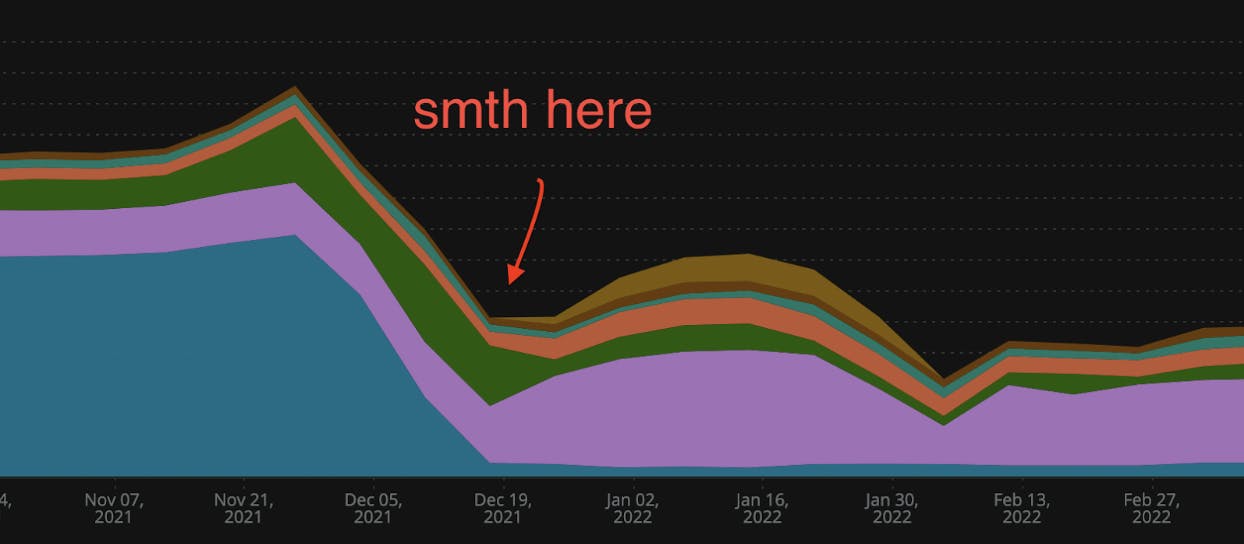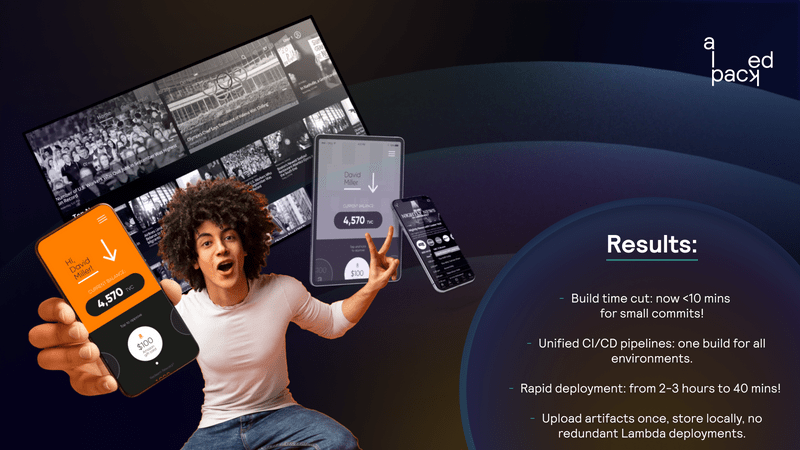A thriving NFT marketplace stands on three pillars: security, scalability, and performance. If you want your platform to withstand the test of time, you need to fortify them. This can be done by optimizing the infrastructure, cloud architecture, and traffic routing — tasks you can accomplish with DevOps and Infrastructure as Code expertise.
NFT Company (NDA)
The client provided a decentralized marketplace where users could mint, discover, and trade non-fungible tokens (NFTs) on multiple blockchain networks (including Ethereum, Solana, Polygon, and Binance Smart). Their other solution was a creator suite that enabled companies to build their own NFT storefronts — like Shopify for Web3 commerce.
TEAM
20-50 people
PERIOD OF COLLABORATION
November 2021 - June 2022
CLIENT’S LOCATION
Hong Kong
About the client
In November 2021, a company in the NFT industry asked us to optimize the AWS-based Kubernetes cluster for its blockchain platform. The goal was to make the infrastructure more secure, scalable, and production-ready.
The client provided a decentralized marketplace where users could mint, discover, and trade non-fungible tokens (NFTs) on multiple blockchain networks (including Ethereum, Solana, Polygon, and Binance Smart). Their other solution was a creator suite that enabled companies to build their own NFT storefronts — like Shopify for Web3 commerce.
However, the platform’s inefficiencies limited visibility into the IT cloud architecture and reliability during high-volume traffic surges. The client’s team practiced DevOps but lacked the hands-on experience to fix the problems.
Alpacked’s mastery of DevOps, DevSecOps, and cloud orchestration was just what they needed for the job. We also suggested improving the client’s CI/CD pipeline with efficient DevOps solutions for better observability.
Among other tools, the client used:

Pulumi

NestJS

React

New Relic

Kubernetes

Istio

Node.js

AWS
Uncovering Key Challenges
When they approached us, the client wasn’t fully aware of all the issues they were facing. We did preliminary research and communicated with the in-house developers to outline the key issues.
1
Challenge #1: Scalability for high-traffic loads
The NFT marketplaces must handle a large influx of users and resource-heavy on-chain and off-chain transactions. Most platforms run into a scalability trilemma — they have to sacrifice proficiency with one of the pillars (performance, scalability, or security). But our goal was to optimize, not compromise. We wanted the infrastructure to be responsive while retaining other qualities.
2
Challenge #2: Vulnerability to DDoS attacks
Distributed denial of service (DDoS) attacks can render the NFT marketplace inaccessible or disrupt some services. This already made some Web3 platforms lose a hunk of their market cap and NFT value in record time. Therefore, protecting the platform against such risks was crucial for the client’s reputation and financial well-being.
3
Challenge #3: Limited visibility of the distributed infrastructure
The client used New Relic to monitor its cluster. The problem was that they did not leverage the platform’s capabilities to gain complete visibility into the NFT marketplace’s infrastructure. We needed to optimize the platform to help the client collect relevant container metrics and metadata for more effective container orchestration.
4
Challenge #4: Inefficient traffic routing policies
Traffic routing determines the speed at which your NFT marketplace can process user requests. This ultimately affects the user experience, limits scalability, and drives up infrastructure maintenance costs. Our goal was to identify the routing bottlenecks, assess their impact, and formulate better rules.
Fortifying and Enhancing the Cloud Infrastructure
Discovery phase and planning
The preliminary research was our starting point for the full-scale discovery phase. We discussed the client’s business goals, requirements, and expectations.
Alpacked examined the existing infrastructure environment and cloud architecture powering their NFT marketplace. The current state was compared to the desired state to identify gaps and opportunities for improvement.
After agreeing on the scope of work, we created an action plan that outlined how to address each challenge. The document covered the specific tasks, work schedule, budget requirements, and deliverables.
Implementation and execution
Solution #1: Optimized infrastructure monitoring
We optimized the New Relic observability platform for the client’s development team. This included the following:
- Setting up performance metrics. Relevant metrics provided the company with real-time data about the core containers and applications on the cluster.
- Adding automated alerts. These alerts should notify the development team of potential issues to help them avert service-disruptive threats.
- Creating custom dashboards. Charts and dashboards simplified monitoring of the platform’s infrastructure by showcasing essential information at a glance.

Solution #2: Refactored autoscaling with custom rules
Our DevOps team refined the autoscaling and implemented rules to allow the NFT marketplace to handle more intensive operations.
- Autoscaling policies. We configured the AWS autoscaling services to ensure the cluster had enough resources to tackle the platform’s service-level agreements.
- Resource allocation. We analyzed the client's infrastructure usage patterns and adjusted resource allocation to prevent under and over-provisioning.
Adaptive scaling. We incorporated rules to anticipate peak activity periods, ensuring a seamless user experience during high-traffic loads.
Solution #3: Implemented flexible traffic routing policies
Existing routing policies were poorly optimized for a Web3-based web application. So, we implemented a set of rules to improve the platform’s performance.
- Load balancing. These policies distributed incoming traffic across the cluster to reduce pressure on individual nodes.
- Rule-based routing. We employed geographical and latency-based rules to optimize the response times for users in different regions.
Continuous health checks. Health check scripts were integrated into the CI/CD to automatically check infrastructure components before deployment.
Let's arrange a free consultation
Just fill the form below and we will contaсt you via email to arrange a free call to discuss your project and estimates.
Solution #4: Prepared for DDoS attacks
Alpacked made the NFT marketplace more resilient against targeted attacks by taking these measures:
- Rate limiting policies. The system could identify and block a sudden flurry of requests that would otherwise overwhelm it.
- Traffic filtering. We implemented DDoS protection tools and rules to stop activities that could affect the platform’s performance.
Distributed servers. Content Delivery Networks reduced the server load by caching static assets and being able to absorb part of the traffic during attacks.
Cross-team collaboration
Our engineers collaborated closely with the client’s team. We met regularly, reviewed changes, and shared insights to speed up the implementation.
The client was interested in improving its infrastructure management. So, after optimizing the system, we also helped their team implement DevOps practices and Infrastructure as Code framework into their workflow.
In the end, we prepared a comprehensive presentation that showcased our achievements. It confirmed that we met all the objectives according to the action plan.
Let's arrange a free consultation
Just fill the form below and we will contaсt you via email to arrange a free call to discuss your project and estimates.
Results: Uncompromisingly Scalable NFT Marketplace
A team of two DevOps solutions experts completed all the tasks by June 2022. As our client put it, we adopted a reasonably good platform, tackled the missing pieces, and provided them with a highly-scalable and easily observable cluster.
- Scaling rules and resource allocation allowed the NFT marketplace to remain high-performing even during peak times.
- We helped the developers leverage the New Relic platform to its full potential and promptly identify and address bottlenecks.
- Flexible traffic routing and autoscaling reduced the resource overhead and halved the maintenance expenses.
- Our efforts to bolster the platform's security made it more resilient to targeted attacks, often leading to expensive downtime.
- The optimization we made contributed to faster response times which, in turn, ensured a smoother user experience.
This project highlighted the importance of proper documentation. The thoroughly conducted discovery session and detailed action plan helped meet all needs and expectations. At the same time, our proficiency with DevOps for enterprises was essential in bridging the project together promptly.


